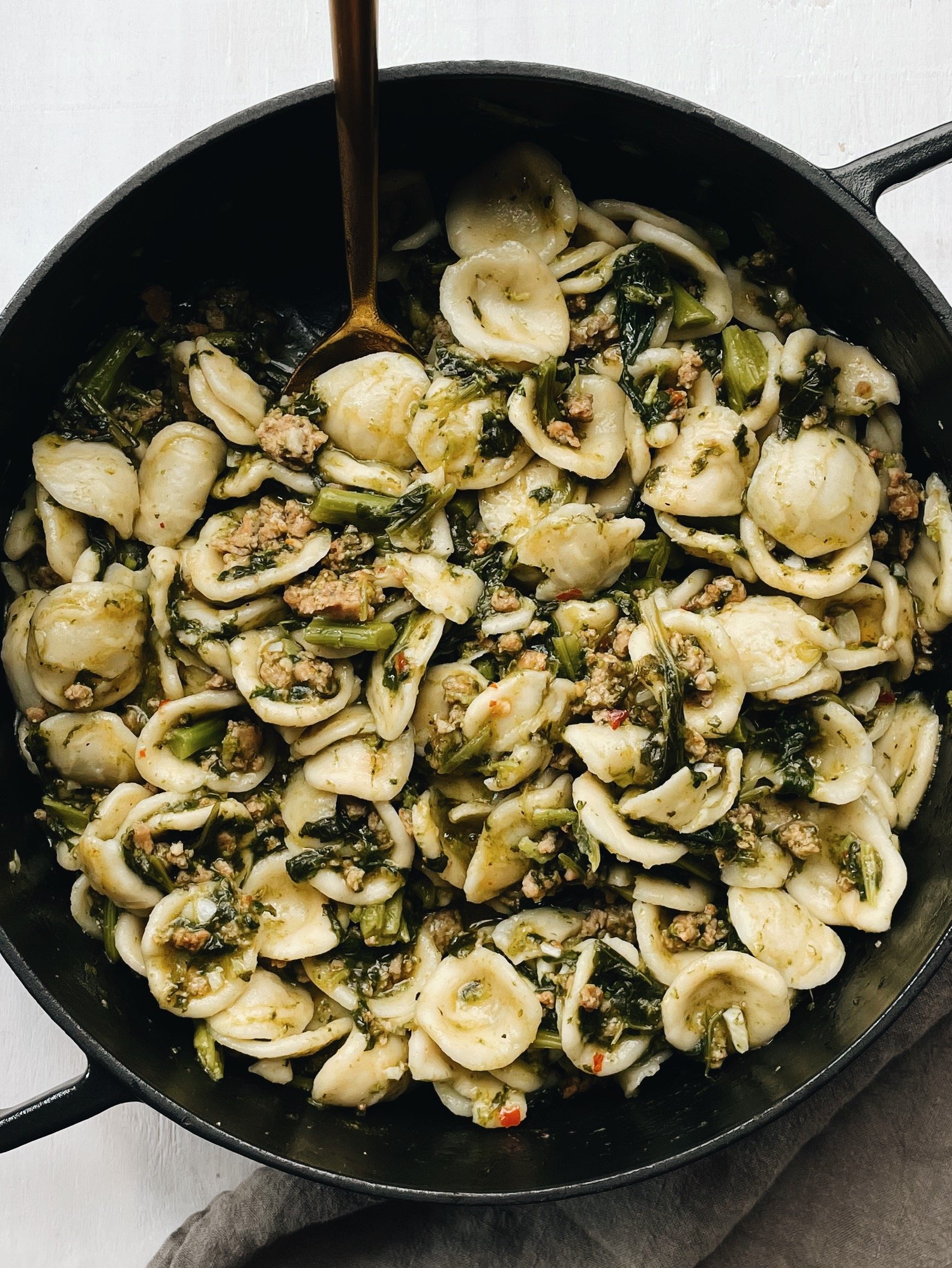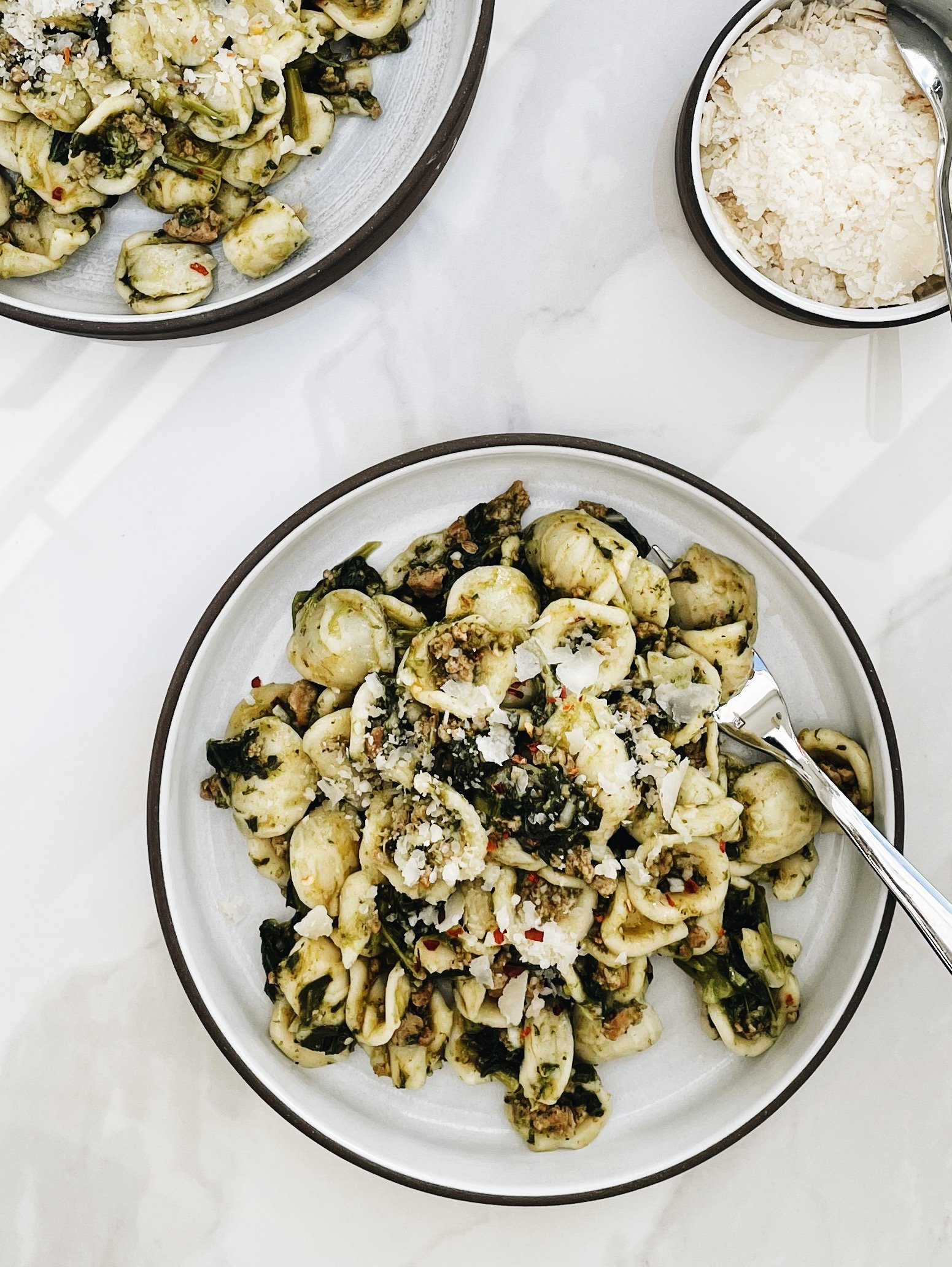orecchiette with sausage and rapini
At 21, I lived in a quiet loft apartment on a tree-lined street whose peaceful stillness was sliced cleanly in thirds by a pair of train lines. It was across from a Trader Joe’s, with a tiny kitchen and a balcony on which I would watch storms brewing over the skyline, sipping $4 wine from a dishwasher-chipped glass in an attempt to suppress the overwhelming dread of the prospect of having to be an adult for the rest of my life. This is where I “learned to cook”—and this dish was one of the first things I ever made by myself.
Yet my first attempt totally sucked. My kitchen was a mess, my broccolini was bitter and also totally the wrong vegetable, my orecchiette was undercooked in the middle, there was cheese film glued into the pan—but I was so proud that I did it that I brought my plate outside and and took a terribly composed, badly lit picture on an actual digital camera. Here he is!
This recipe was originally published in 2017, but after making it many more times since, my technique has evolved even further—and now bears almost no resemblance to my first try. My updated-for-2022 technique begins by deeply browning some un-cased sausages, smashing them up to a fine grind with a spatula to fry in a little olive oil until very crispy. While that’s happening, you use the boiling water of your pasta pot to blanch your rapini, which you then transfer to a bowl full of cold water to rapidly cool down. You add pasta to your neon-green water; this will act as an amplified cooking liquid when you finish your sauce at the end. At this point, you add garlic to your sausage and deglaze with white wine. After chopping up your cooled rapini, you let that simmer with the sausage until the pasta is just shy of al dente. Then using a slotted pasta scoop, you transfer it right over—no draining!—and stir to coat with all the pan fat. Melt in 2 tbsp. of butter and splash in some pasta water, and you get a silky, almost brothy sauce that pools in the orecchiette nooks. The best part? This all takes about 30 minutes.
Note dramatic improvements in lighting and composition
This dish is actually from Bari, where my grandmother was from, although I didn’t realize this until last year. Some light research revealed that—surprise!—multiple conflicting versions of this dish exist, none of them definitively correct. Some tone it down with mild sausage or turn it up with extra chiles, some use wine and some don’t, some swap savory anchovies instead of pork or use toasted breadcrumbs instead of cheese. But no matter which version you find, it will always be a fairly short ingredient list, meaning the ones you choose and the way you treat them matters more than usual. Let’s break it down:
The sausage. While you can use hot or mild, I prefer the extra spice and flavor of the former. You remove it from its casings and fry in a small amount of oil. The trick is to heat it on a large enough surface area to truly brown and crisp rather than steam, and to chop it up as finely as you can with the sharp side of a spatula. Then you press the finely ground sausage down into the oil with your spatula and leave it to cook, totally undisturbed, until you have a big crispy sheet of sausage. Repeat twice. This makes a huge difference in the final dish.
The rapini. Some call it broccoli rabe, some call it rapini, but whatever name you find it under, you’re looking for bright green fluffy bunches with lots of leaves and tiny florets—not the stalky form of baby broccoli / broccolini, which is a totally different vegetable. It’s worth tracking down for this recipe.
The pasta. I always use orecchiette in this dish, the traditional Pugliese shape that means (and looks like) “little ears.” Orecchiette varies a lot by brand, but the one I’ve used here is Trader Joe’s Organic Artisan variety. I prefer the kind that has a random veiny pattern on the outside, rather than the ridges; these cook up thicker and starchier, with more satisfying texture. If you can’t find orecchiette at all, try penne!
RECIPE
A traditional Italian dish from Bari in Puglia, orecchiette is paired with pork sausage and bitter greens in a garlicky white wine sauce punctuated with a few pinches of spicy chili flakes.
Effortful time: 30 minutes
Total time: 30 minutes
Serves: 4
YOU NEED
1 tbsp. extra-virgin olive oil
1 lb. hot Italian pork sausage, bulk or casings removed
4 cloves garlic, minced
1 tbsp. chili flakes, optional
1 large bunch rapini, rinsed and stems trimmed
3/4 cup dry white wine
12 oz. orecchiette pasta (or sub penne)
2 tbsp. butter
Salt and pepper, to taste
Shaved parm, for serving
MAKE IT
Get prepped. Bring salted water in a pasta pot to a boil. Mince your garlic and trim the frayed ends off your rapini. Slice open your sausages if yours came with casings. Get your wine ready since that step goes fast.
Deeply brown the sausage. In a large sauté pan or cast-iron braiser, heat 1 tbsp extra-virgin olive oil over medium heat. Add your de-cased sausages and begin to break up with a rigid spatula, using the hard edge to really grind the meat into small pieces. Let it fry until very crispy, about 10-15 minutes.
Blanch the rapini. As your sausage finishes, your water will likely be boiling. Add whole trimmed rapini and cook 5 minutes, until very bright green but not wilted. Use tongs to remove it straight into a bowl of very cold water. Leave it there for a bit. Bring your weird green water back to a boil—you’re going to use it for the pasta.
Cook the pasta. Set a timer for 2 minutes under the lowest number on the package; we’ll be finishing it in the sausage-rapini sauce.
Prepare the cooked rapini. Remove the rapini from its cold water bowl and lay it on a cutting board. Chop roughly, ensuring no pieces are too huge for one bite.
Sauté the aromatics. Clear a small space in your sausage pan. Add another tbsp of olive oil and fry the chili flakes and minced garlic until the garlic is just golden, not more than 1 minute.
Deglaze and add the rapini. Once the garlic is fragrant, deglaze with the white wine. Let boil for 1 minute, until the wine has begun to reduce. Add the rapini to the skillet and stir to coat. Let this simmer on low until your pasta is ready.
Combine the pasta into the skillet. Transfer using a slotted pasta scoop straight into the sauté pan. Save 1 cup of pasta water. Add 2 tbsp. butter and splashes of pasta water and stir, about 2-3 more minutes or until you have a glossy sauce that pools like a thick broth around the orecchiette.
Serve it up. Spoon into bowls and top with freshly grated cheese.



